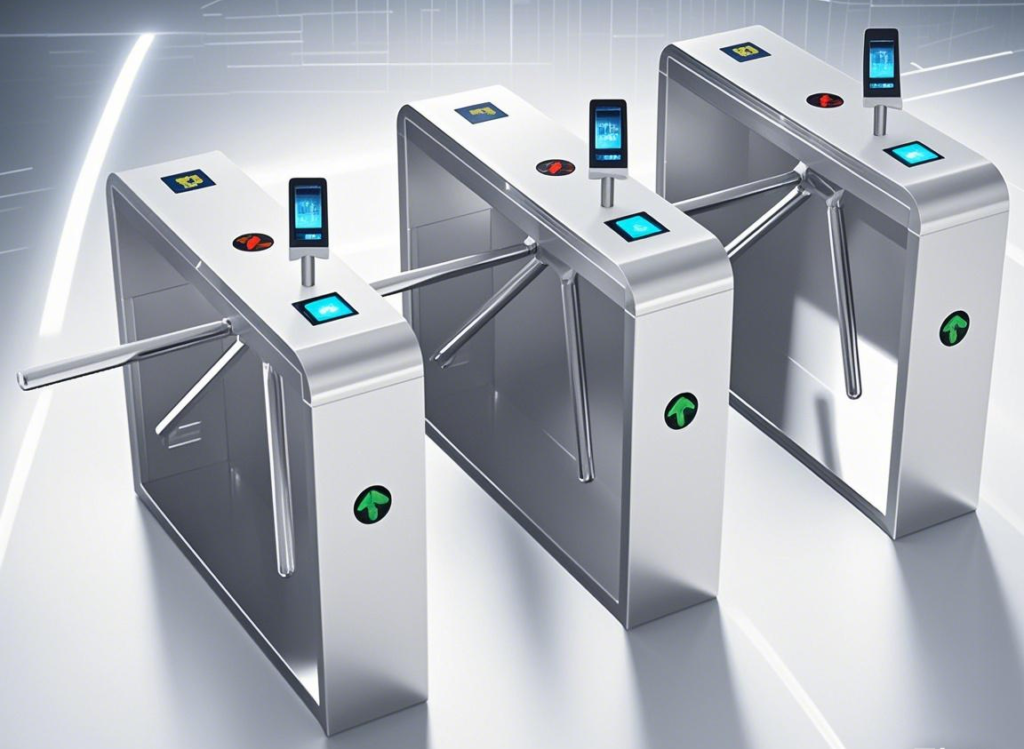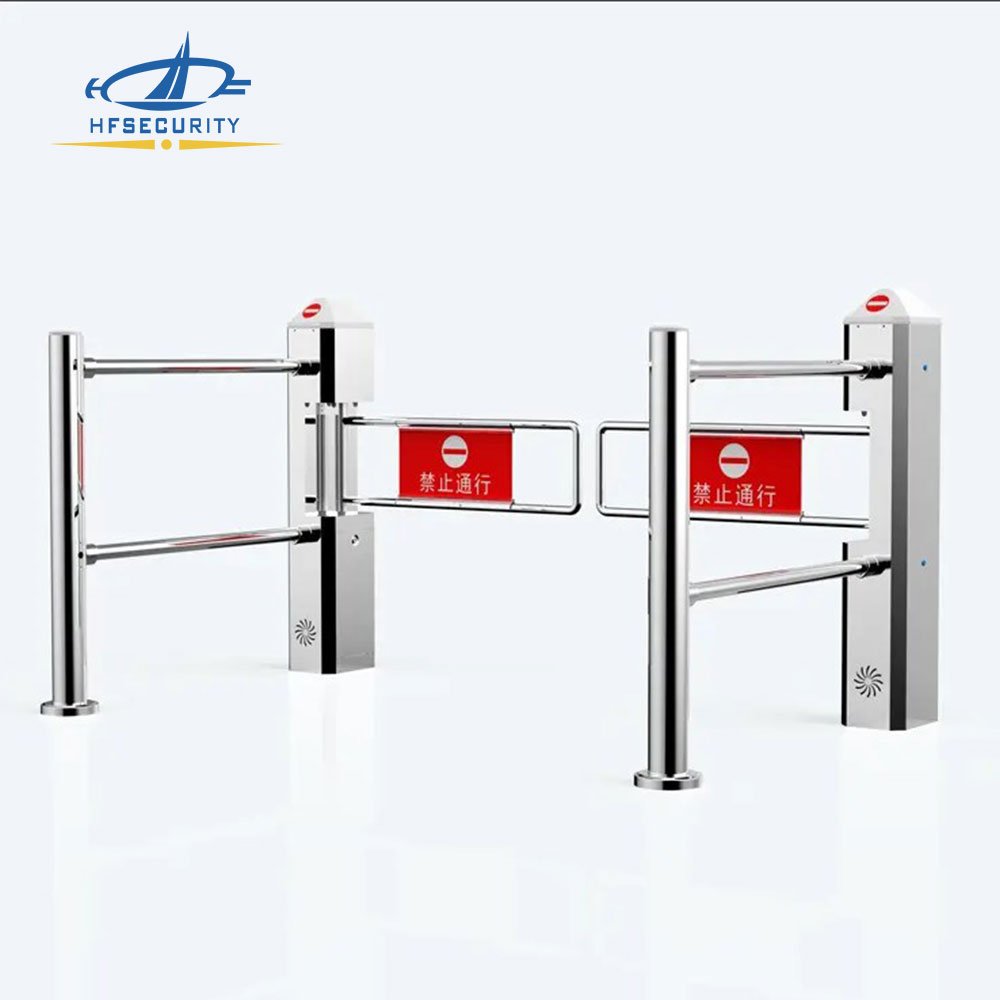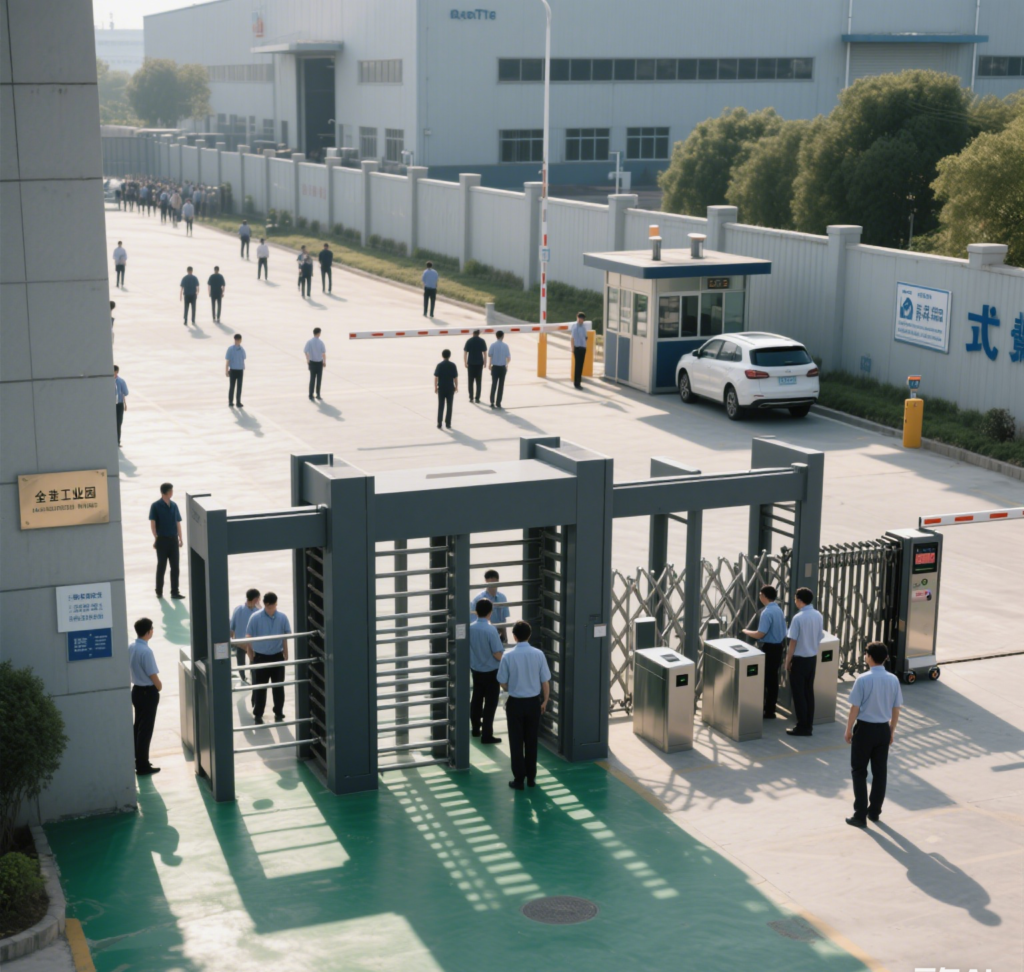Turnstile gates are physical barriers integrated with electronic access control systems to manage the flow of people entering or exiting a secured area. These gates offer a balance between security enforcement and efficient crowd movement, making them essential in many modern environments such as office buildings, transit stations, stadiums, and factories.
This article explores the types and applications of turnstile gates, highlighting the technical differences and practical use cases for each category.
Main Types of Turnstile Gates
There are several turnstile gate types, each designed for specific security levels, space availability, and traffic flow requirements. Below are the most common types used in today’s access control systems.
1. Tripod Turnstiles
Tripod turnstiles are one of the most widely used and affordable options in physical access control. These gates consist of three rotating horizontal arms that allow passage of one person at a time. They are often built with stainless steel for durability and can operate in both directions.
Operation: Semi-automatic or fully automatic with motorized rotation
Use Case: Office entrances, gyms, metro stations
Pros: Low cost, simple to install, durable
Cons: Not suitable for disabled access or areas requiring high speed
Tripod turnstiles are ideal for moderate-security environments that require orderly pedestrian flow and basic access control.
2. Swing Barrier Turnstiles
Swing barrier turnstiles are designed with rotating doors or panels that open in a swing motion. These gates can be built from tempered glass, acrylic, or stainless steel and are often used in locations where aesthetics and accessibility are equally important.
Operation: Motorized swinging arms, often integrated with access systems
Use Case: Building lobbies, libraries, corporate offices
Pros: Visually appealing, supports wider lanes for wheelchair access
Cons: More expensive than tripod turnstiles
Swing gates are a versatile and elegant solution for medium-security settings that require high throughput and inclusive access.
3. Sliding Turnstiles
Sliding turnstile gates are high-end security barriers that use sliding panels—typically made of glass—that retract into the body of the unit upon valid authentication. These gates offer a sleek, modern appearance and fast opening/closing speeds.
Operation: Motor-driven with programmable logic and IR sensors
Use Case: Airports, R&D labs, financial institutions
Pros: Fast operation, premium design, advanced safety features
Cons: High initial cost, requires more space
Sliding gates are well-suited for high-traffic and image-sensitive locations where both security and style are essential.
4. Full-Height Turnstiles
Full-height turnstiles are rugged, floor-to-ceiling barriers designed to provide the highest level of access control. Constructed from heavy-duty materials, they eliminate tailgating and climbing attempts and are often used in outdoor or industrial areas.
Operation: Mechanical or motorized with electronic locking
Use Case: Stadiums, construction sites, prisons, data centers
Pros: High-level physical security, anti-trespass design
Cons: Bulky, not ideal for indoor or decorative environments
These gates are perfect for critical infrastructure zones requiring strict perimeter security and unmanned operation.
Key Applications of Turnstile Gate Systems
Understanding where these gates are used is crucial to appreciating their value in modern infrastructure:
1. Corporate Offices
In modern workplaces, turnstile gates serve as the first line of security and employee management. Integrated with RFID cards, fingerprint scanners, or facial recognition systems, they help monitor and record staff attendance in real time.
Turnstile gates can be linked to HR and time-tracking systems to automate clock-in/clock-out.
Visitor management modules allow integration with QR code or temporary access pass systems.
High-end swing or optical turnstiles are often chosen for executive office floors to match interior design and deliver a seamless access experience.
This setup helps prevent unauthorized entry, streamline workflows, and enhance data-driven workforce management.
2. Public Transportation
Turnstile gates are crucial in transit systems such as subways, bus terminals, and railway stations, where managing large crowds efficiently and securely is a priority.
Ticket validation through magnetic stripe cards, contactless IC cards, or mobile QR codes is automated at the gate.
Flap and tripod turnstiles are widely used due to their high throughput capability and rugged design.
Some advanced metro systems integrate turnstiles with facial recognition and thermal imaging for health monitoring and identity tracking.
Turnstiles help ensure fare compliance, prevent overcrowding, and collect real-time traffic data for public transport optimization.
3. Sports & Entertainment Venues
Stadiums, theme parks, concert halls, and exhibition centers use turnstile gate systems to control access to events and enforce ticket validation.
Full-height or high-speed swing turnstiles are installed at venue entrances to handle large crowds safely.
Integrated barcode or NFC scanning allows for fast digital ticket validation.
Turnstiles can be connected to central event management platforms for capacity monitoring and crowd analytics.
These systems not only improve operational efficiency during peak entry times but also enhance security by filtering out fake ticket holders and unauthorized entrants.
4. Industrial Facilities
In industrial and high-risk environments such as factories, warehouses, construction sites, and power plants, turnstile gates act as both security and safety barriers.
Only authorized personnel with valid credentials (biometric or RFID) can access high-security zones.
Integration with personal protective equipment (PPE) detection systems can restrict access if workers are not properly equipped.
Full-height turnstiles are often used to completely block unauthorized access and eliminate tailgating.
Combined with access logs, these gates help organizations enforce occupational safety standards, zone restrictions, and shift-based entry rules.
5. Educational Institutions
Universities, colleges, and schools deploy turnstile gates to enhance campus security and manage student movement.
Turnstiles at dormitory entrances, libraries, or examination halls can be connected to student ID card systems.
Attendance can be automatically recorded when students pass through designated gates.
Access schedules can be customized—for example, limiting after-hours entry to specific zones.
This approach helps prevent trespassing, improve student safety, and streamline access control across large educational campuses.
6. Healthcare & Government Buildings
Hospitals, clinics, and government service centers rely on turnstile gates to manage the high volume of daily visitors and protect sensitive zones.
In healthcare settings, contactless optical or sliding turnstiles are favored for hygiene and speed, often integrated with thermal cameras to detect body temperature.
In government buildings, biometric-enabled gates restrict access to specific departments or staff-only areas.
Visitor registration systems can issue one-time QR codes that are validated at the turnstile for temporary access.
By securing entrances and regulating foot traffic, these gates help protect patient data, sensitive government documents, and critical infrastructure from unauthorized access.
Comparison Table: Types of Turnstile Gates
The table below compares the most common turnstile gate types in terms of design, access options, best use cases, and security levels—excluding optical turnstiles:
Advanced Features & Integration Options
Modern turnstile access control systems can be enhanced with technologies such as:
Biometric Identification (Face, Fingerprint, Palm Vein)
RFID Card Readers
QR Code Scanners
Anti-tailgating Sensors
Alarm Systems
Real-time Access Logs & Software Integration
These features turn turnstile gates into smart entry solutions, capable of real-time data communication and centralized control.
Conclusion
The types and applications of turnstile gates are diverse and adaptable. Whether you need cost-effective crowd control, elegant lobby access, or high-security perimeter defense, there’s a turnstile solution designed for your environment.
By assessing your traffic volume, location type, and security level, you can select the most suitable turnstile gate type that supports your operational goals and compliance needs.





